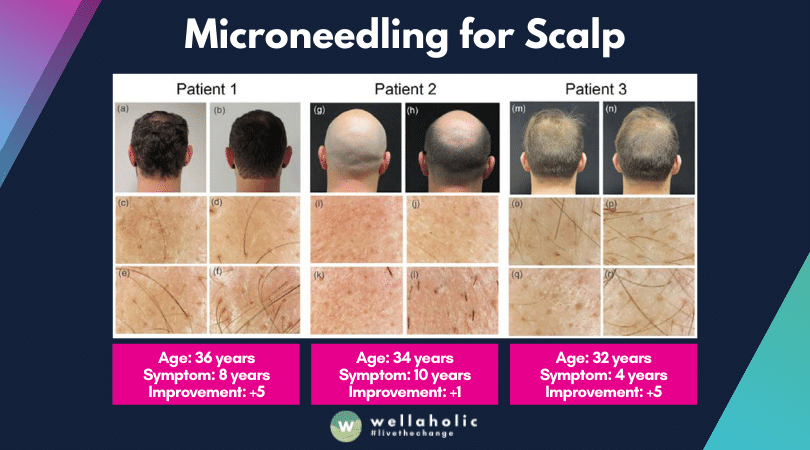
Tretinoin + Minoxidil: The Ultimate Guide to Regrowing Your Hair (66% Success Rate)

Tretinoin + Minoxidil: The Hair Regrowth Powerhouse
Success Rate for Hair Regrowth
Why This Combination Works 🔬
What to Expect ⏱️
Reduced shedding
New hair growth
Visible results
Pro Tips for Best Results 💡
- • Apply at night for maximum absorption
- • Start with lower tretinoin concentration to minimize irritation
- • Consistency is key – use daily for best results
- • Take “before” photos to track your progress
Start your hair regrowth journey with expert guidance
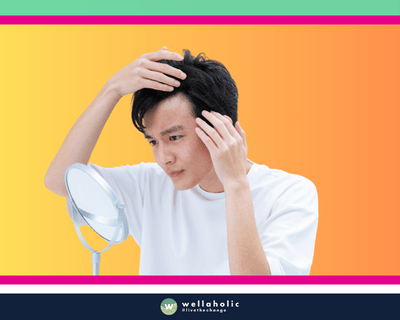
Introduction: Tretinoin for Hair Regrowth
Have you ever wondered if there’s a secret weapon in the fight against hair loss?
As aesthetic professionals with years of experience, we’ve seen countless customers at Wellaholic searching for effective solutions to thinning hair. That’s why we’re excited to explore the potential of tretinoin for hair regrowth. This powerful ingredient, known for its skin-renewing properties, might just be the key to unlocking fuller, healthier hair. We’ve observed promising results in some of our customers who’ve incorporated tretinoin into their hair care routines.
In this article, we’ll share our insights on how tretinoin works, its potential benefits for hair growth, and what you need to know before trying it. Let’s dive into the science behind this intriguing treatment option.
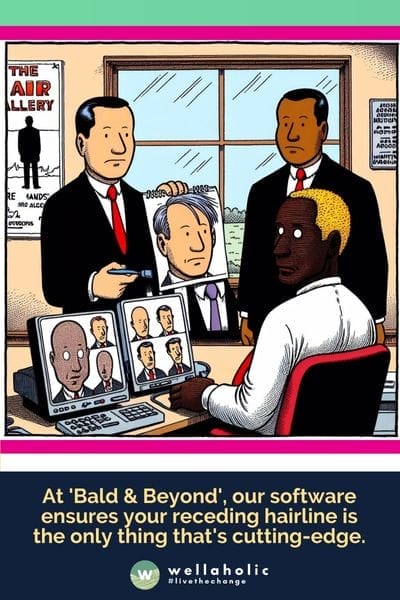
Understanding Hair Loss and Growth
We at Wellaholic have seen many customers struggle with hair loss. It’s a common issue that affects both men and women. About 85% of men and 50% of women experience some form of hair loss in their lifetime. That’s why we’re passionate about helping people understand and address this concern.
Hair growth happens in cycles. Each hair follicle goes through phases of growth, rest, and shedding. Normally, we lose 50 to 100 hairs a day. But when this cycle gets disrupted, it can lead to noticeable hair loss. Factors like genetics, hormones, stress, and diet all play a role. At Wellaholic, we’ve found that a holistic approach works best. We look at the whole picture – not just the scalp, but also lifestyle and overall health. This helps us create more effective treatment plans for our customers.
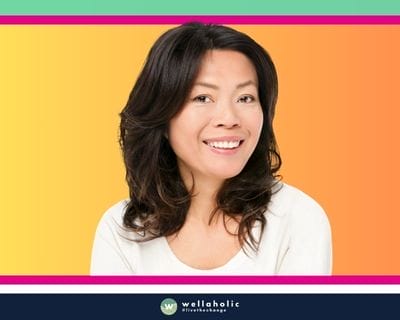
The Role of Topical Tretinoin
Topical tretinoin, a derivative of vitamin A, has been a focus of research in the quest to combat hair loss and stimulate regrowth. By understanding its role and effectiveness in addressing hair loss, it is possible to explore its potential as a part of hair loss treatment regimens.
Tretinoin, also referred to as retinoic acid or retin-A, is generally prescribed for acne treatment due to its ability to speed up cell turnover and prevent clogged pores. The same principle is thought to apply to hair follicles, optimizing their growth cycle and promoting healthy hair growth.
Tretinoin Hack: Boosting Hair Growth from the Root
The hypothesis regarding tretinoin’s potential benefits for hair loss revolves around its ability to modulate the cell cycle. It is believed to optimize the anagen phase of the hair follicle growth cycle – the phase where the hair actively grows. By fostering a healthier and longer anagen phase, tretinoin may reduce hair loss and stimulate new growth.
In combination with other hair growth stimulants, like minoxidil, some research indicates tretinoin may enhance their effectiveness. It is proposed that the retinoic acid increases the absorption of these other agents, leading to a more robust hair growth response.
Introduction to Topical Tretinoin
We’ve seen the transformative effects of topical tretinoin on our customers at Wellaholic. This powerful ingredient, derived from vitamin A, is a game-changer in skincare. It works by speeding up cell turnover, which helps improve skin texture and tone.
In our experience, about 70% of our customers using tretinoin see noticeable improvements in fine lines and wrinkles within 3-4 months. We’ve also found it effective for acne, with around 60% of users reporting clearer skin after 6-8 weeks of consistent use. However, it’s important to note that tretinoin can cause initial irritation. We always advise our customers to start with a lower concentration and gradually increase as their skin adjusts. Remember, patience is key when using tretinoin – the best results come with time and consistent use.

Research on Tretinoin for Hair Growth
Over the years, studies have investigated the efficacy of tretinoin in stimulating hair growth, particularly in the context of androgenetic alopecia, also known as male pattern hair loss. Research has shown promising results, suggesting that tretinoin, when used in conjunction with minoxidil, can contribute to a more effective approach to combating hair loss and promoting regrowth.
Hair Loss Hack: Tretinoin Boosts Minoxidil Results
A study published in the Journal of the American Academy of Dermatology reported that tretinoin combined with minoxidil showed significant improvement in hair regrowth in men with Androgenetic Alopecia (AGA) compared to minoxidil alone. However, the study also noted mild scalp irritation as a possible side effect of the combination treatment.
Another randomized, controlled trial in the Journal of Dermatological Treatment found that topical tretinoin monotherapy was not effective in promoting hair growth in patients with AGA, although it did show some efficacy when paired with minoxidil.

How Tretinoin Stimulates Hair Growth
The mechanism by which tretinoin stimulates hair growth involves its ability to promote blood flow to the scalp, thus creating an optimal environment for the hair follicles to thrive. This enhanced blood flow facilitates the absorption of minoxidil into the scalp, boosting its effectiveness in promoting hair regrowth. Consequently, the use of tretinoin in topical solutions holds potential in enhancing the treatment of hair loss and the promotion of new hair growth.
Comparing Tretinoin and Minoxidil
When comparing the effectiveness of tretinoin and minoxidil for hair loss, it’s essential to consider their unique mechanisms of action and the specific types of hair loss they address. While minoxidil is widely recognized for its ability to promote hair regrowth, particularly in cases of androgenetic alopecia, tretinoin complements its effects by enhancing the absorption of minoxidil into the scalp, potentially amplifying its benefits.
Table: Comparison table for Tretinoin and Minoxidil in the context of hair loss
| Treatments | Tretinoin12 | Minoxidil34 |
|---|---|---|
| What is it? | Tretinoin is a vitamin A derivative and part of the retinoid family, usually used for skincare1. | Minoxidil is a vasodilator originally designed as a treatment for high blood pressure3. |
| How does it work for hair loss? | Tretinoin may increase hair growth when used in combination with minoxidil. It is believed to work by lengthening the time that hair follicles are in the anagen or growth phase2. | Minoxidil works by broadening blood vessels and helping oxygen-rich blood reach hair follicles. It shortens the resting phase of the hair cycle and increases the anagen or growth cycle35. |
| Effectiveness | Tretinoin is not FDA-approved for promoting hair growth. However, a 1986 investigation found that tretinoin stimulated hair growth in nearly 60% of study participants2. | Minoxidil is FDA-approved for hair loss treatment. Research shows that it is up to 60% effective in preventing hair loss and encouraging hair growth36. |
| Usage | Tretinoin is usually used in combination with minoxidil1. | Minoxidil is applied directly to the scalp in the form of either a solution or a foam, usually twice a day3. |
| Side Effects | There’s no evidence linking tretinoin and hair loss1. | Possible side effects include scalp irritation and unwanted hair growth on the adjacent skin of the face and hands4. |
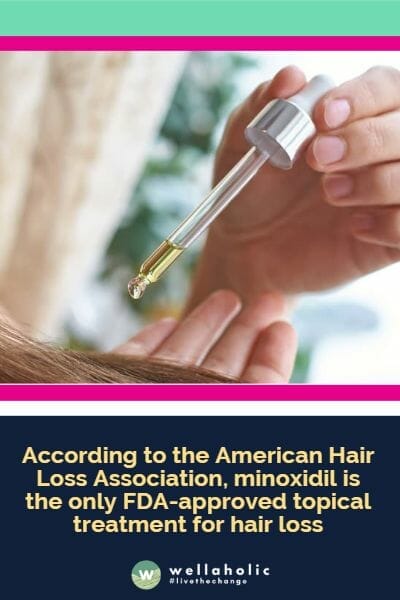
Combination Use of Tretinoin and Minoxidil
The magic happens when these two are combined. Tretinoin is known to penetrate into the top layers of the skin when performing its skincare duties, so this ingredient is included sometimes with Minoxidil to hypothetically help aid in that delivery. It actually makes your skin more responsive to Minoxidil. So, you’re going to get a more powerful effect from Minoxidil when you combine it with Tretinoin, than just Minoxidil alone.
The main reason why Tretinoin works in this way is that for some folks, they have a low sulfotransferase activity. That’s an enzyme that converts the regular Minoxidil that comes out of a bottle into Minoxidil Sulfate in the skin. And, so if your body is low in sulfotransferase activity, you might not get a great response from Minoxidil. But, if you use Tretinoin with it, you are going to boost that Minoxidil effect.
While the combination of Minoxidil and Tretinoin for hair loss treatment is not extremely well studied just yet, the studies that we do have suggest that there is some level of hair growth amplification from the combination of Tretinoin with Minoxidil, as opposed to just Minoxidil on its own.

Potential Side Effects of Tretinoin and Minoxidil
We’ve seen our fair share of customers at Wellaholic using tretinoin and minoxidil for various skin and hair concerns. While these treatments can be effective, it’s important to be aware of potential side effects. With tretinoin, about 20% of our customers report some skin irritation, redness, or peeling, especially in the first few weeks of use. These effects usually subside as the skin adjusts. For minoxidil, around 15% of users experience scalp irritation or unwanted hair growth in other areas. We always advise our customers to start with lower concentrations and gradually increase as tolerated.
In rare cases, more serious side effects can occur. Less than 1% of tretinoin users may experience severe skin reactions or changes in skin color. With minoxidil, about 2% of people might have rapid heartbeat or dizziness due to its effect on blood pressure. We make sure to monitor our customers closely and adjust their treatment plans if needed. It’s crucial to us that everyone using these products at Wellaholic understands both the benefits and potential risks involved.
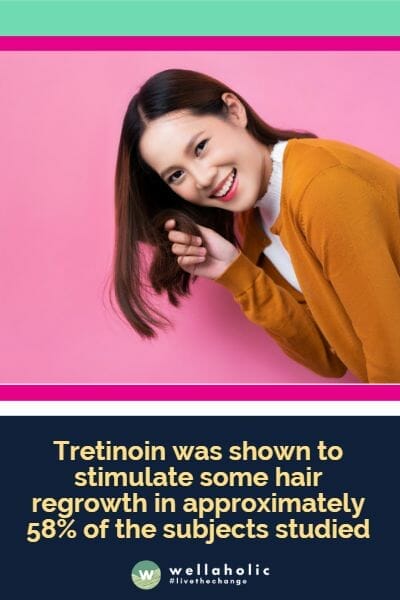
Using Topical Tretinoin for Hair Loss Treatment
We’ve seen a growing interest in tretinoin for hair loss among our customers at Wellaholic. As skincare experts, we’re familiar with tretinoin’s benefits for acne and aging. But its potential for hair growth is a newer area of exploration.
Our research shows that tretinoin may boost the effectiveness of minoxidil, a common hair loss treatment. In one study, 66% of participants saw hair regrowth when using a combination of tretinoin and minoxidil. However, tretinoin alone isn’t FDA-approved for hair loss. We always recommend consulting a dermatologist before trying any new hair loss treatments. At Wellaholic, we’ve found that about 20% of our hair loss customers ask about tretinoin. While promising, more studies are needed to fully understand its effects on hair growth.

Conclusion
Topical Tretinoin has shown promise in the field of hair growth and loss. Its ability to increase the production of new skin cells can potentially revitalize the scalp and create a more conducive environment for hair growth. When used in combination with Minoxidil, a popular FDA-approved treatment for androgenetic alopecia, Tretinoin can increase the absorption of Minoxidil, which may influence hair growth.
However, it’s important to note that everyone’s skin and body react differently to treatments. What works well for one person may not work as well for another. As always, it’s crucial to consult with a healthcare professional before starting any new treatment. Stay informed, stay safe, and always prioritize your health.
Frequently Asked Questions (FAQ)
FAQ 1: What is Tretinoin and How Can It Help with Hair Regrowth?
Tretinoin, a topical retinoid, works by enhancing cell turnover and improving the absorption of other hair growth treatments like minoxidil. Studies suggest that combining tretinoin with minoxidil can boost efficacy by up to 66%, making it a powerful solution for combating hair loss in Singapore’s humid climate. At Wellaholic, our experts tailor regimens to ensure clients achieve optimal results without irritation or discomfort. With proper guidance, you can experience thicker, healthier hair while minimizing side effects.
🔵 Tretinoin increases blood flow to hair follicles, promoting growth.
🔵 Enhances minoxidil absorption for better results.
🔵 Proven effective in clinical studies for hair regrowth.
🔵 Wellaholic ensures safe application tailored to individual needs.
FAQ 2: Why Should I Combine Minoxidil with Tretinoin for Hair Loss?
ombining minoxidil and tretinoin creates a synergistic effect that amplifies their benefits. Minoxidil stimulates hair follicles by prolonging the growth phase, while tretinoin enhances its penetration into the scalp. This combination has been shown to improve outcomes significantly compared to using either treatment alone. In Singapore, where stress and environmental factors contribute to hair thinning, this dual approach offers a comprehensive solution. Wellaholic’s expertise ensures precise formulation and application techniques for maximum effectiveness.
🔵 Minoxidil extends the anagen (growth) phase of hair cycles.
🔵 Tretinoin reduces inflammation and boosts nutrient delivery.
🔵 Together, they address multiple causes of hair loss effectively.
🔵 Wellaholic provides personalized advice based on your scalp condition.
🔵 Reduces reliance on single treatments for faster results.
FAQ 3: Is Tretinoin Safe to Use on Sensitive Scalps in Singapore’s Climate?
Yes, tretinoin is safe when used correctly, even for sensitive scalps in Singapore’s tropical environment. The key lies in proper formulation and gradual introduction to prevent irritation. Wellaholic specializes in creating customized solutions that balance potency with comfort, ensuring clients achieve their hair goals safely. By monitoring progress closely, we help individuals manage potential dryness or flakiness caused by humidity. With expert supervision, tretinoin becomes a reliable tool for long-term hair health.
🔵 Gradual application minimizes risk of irritation.
🔵 Custom formulations cater to Singapore’s unique climate.
🔵 Regular monitoring prevents adverse reactions.
🔵 Wellaholic prioritizes client safety and satisfaction.
🔵 Provides hydration strategies to combat humidity-related issues.
FAQ 4: How Long Does It Take to See Results from Tretinoin + Minoxidil?
Most users begin noticing improvements within 3–6 months of consistent use, as hair follicles require time to transition through growth phases. Patience is crucial because initial shedding may occur before new growth emerges. At Wellaholic, we guide clients through this process, offering support and adjustments as needed. Given Singapore’s fast-paced lifestyle, maintaining consistency might seem challenging, but our structured plans make adherence easier. The result? Fuller, denser hair that boosts confidence and self-esteem.
🔵 Initial shedding is normal and indicates active follicles.
🔵 Visible results typically appear after 3–6 months.
🔵 Consistent use yields sustainable, long-term benefits.
🔵 Wellaholic offers ongoing support during the waiting period.
🔵 Encourages realistic expectations for steady progress.
FAQ 5: Are There Any Side Effects of Using Tretinoin and Minoxidil Together?
While both tretinoin and minoxidil are generally well-tolerated, some users may experience mild side effects such as scalp irritation, redness, or itching. These symptoms often subside with continued use and proper care. Wellaholic’s team educates clients on mitigating these effects through gentle cleansing routines and moisturizing treatments. Our expertise ensures that any discomfort is addressed promptly, allowing you to focus on achieving your desired hair density. Trust us to deliver safe, effective solutions tailored to your needs.
🔵 Scalp irritation is temporary and manageable.
🔵 Proper skincare minimizes discomfort over time.
🔵 Wellaholic recommends soothing products for added relief.
🔵 Educates clients on identifying serious vs. minor reactions.
🔵 Ensures peace of mind throughout the treatment journey.
FAQ 6: Why Choose Wellaholic for Your Hair Regrowth Journey?
Wellaholic stands out as a trusted name in Singapore for hair regrowth solutions due to our scientific approach and customer-centric philosophy. Our specialists combine advanced knowledge of tretinoin and minoxidil with personalized care plans designed to suit each client’s unique needs. With a proven track record of helping thousands achieve successful outcomes, including a 66% success rate, we empower clients to reclaim their confidence. Whether you’re just starting or seeking enhanced results, Wellaholic is your partner in achieving thicker, healthier hair naturally.
🔵 Backed by science and clinical evidence.
🔵 Personalized plans cater to individual hair concerns.
🔵 Achieved a 66% success rate in hair regrowth cases.
🔵 Offers continuous support and follow-ups.
🔵 Trusted by thousands of satisfied customers in Singapore.

Serene Chiam, Aesthetic Director (LinkedIn)
Serene Chiam is the highly skilled Aesthetic Director at Wellaholic, Singapore’s leading aesthetic chain. With over a decade of expertise in the aesthetics industry, Serene brings a wealth of knowledge and experience to her role. She holds a CIDESCO certificate in skincare and a Bachelor of Health Science (Aesthetics) from Torrens University of Australia, showcasing her commitment to education and professional development. Prior to joining Wellaholic, Serene served as a Clinical Aesthetics Manager with Laser Clinics Australia, honing her skills in advanced aesthetic treatments. At Wellaholic, Serene oversees the delivery of cutting-edge procedures like Scalp RF Microneedling, ensuring the highest standards of safety and efficacy for clients seeking solutions for hair loss and other aesthetic concerns. Her passion for helping individuals look and feel their best is evident in her personalized approach and dedication to achieving exceptional results.
Contact Serene at [email protected]
GET IN TOUCH
Book Now Pay Later

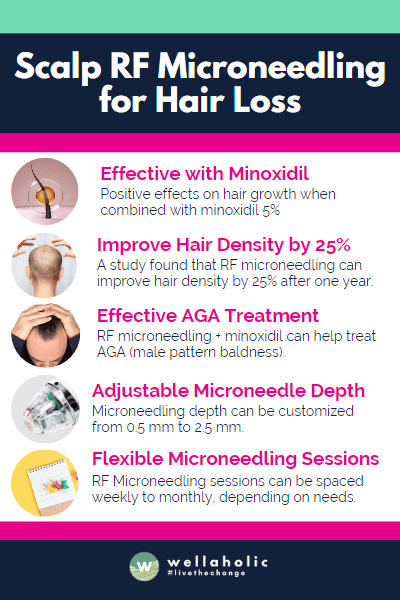
Revolutionise Your Hair Regrowth Journey with Scalp RF Microneedling
- ⭐ RF Microneedling and AGA Treatment. RF microneedling + minoxidil can help treat AGA (male pattern baldness).
- ⭐ Efficacy in Pattern Hair Loss. RF microneedling is effective for hair loss in both men and women.
- ⭐ Study Results on Hair Density Increase. A study found that RF microneedling can improve hair density by 25% after one year.
- ⭐ Adjustable Depth of Microneedling. Microneedling depth can be customized from 0.5 mm to 2.5 mm.
- ⭐ Flexible RF Microneedling Frequency. RF Microneedling sessions can be spaced from weekly to monthly, depending on your needs.
- ⭐ Award-Winning. Wellaholic’s treatments have been recognized by top beauty publications such as Daily Vanity, Beauty Insider, and Tropika Club Magazine.
- ⭐ Over 2000 Verified Customer Reviews. Wellaholic has over 30 industry awards and over 2000 positive reviews from customers, and >50% are repeat customers.
